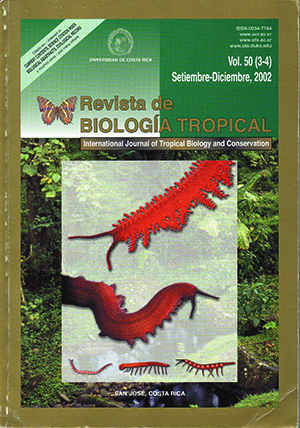Abstract
Donax dentifer is a dominant member of the sandy beach communities of the Colombian Pacific coast. A population of this bivalve was monthly sampled in Playa Chucheros at the Bay of Málaga, Colombian Pacific, between August 1997 and July 1998, during the “El Niño 1997/1998” phenomenon. Quantitative samples were taken in perpendicular and parallel to the coastal line transects to determine the population density and a length-frequency distribution. Qualitative samples were taken to study the reproduction and monthly length weight relationship. Sea surface temperature, dissolved oxygen, salinity and pH in the water was monthly registered in the sampling station. Additionally, a tagging-recapture experiment was performed to growth estimations. Results indicate a continuous reproduction cycle with two annual spawning seasons in December and March. The growth parameters of the non-oscillating von Bertalanffy growth function were K= 0.62 yr-1 and L¥ = 29.3 mm. Mortality (Z) was higher (2.65 yr-1) for small individuals (between 2 mm and 5 mm) while a lower Z value (1.71 yr- 1) were obtained for larger ones (between 19 mm and 25 mm). An annual mean biomass value o f B – = 1.229 g ash-free dry weight m- 2 and an annual somatic production of Ps o m=1.215 g ash-free dry weight m- 2 were estimated, which correspond to a Psom/ B – value of 0.988. Population density increased in November and April, but any population density pattern related with “El Niño” was evident. Low body weight during November- December seems to show a relation between reproductive cycle in D. dentifer and El Niño 97/98 event. The fluctuation in dissolved oxygen show a high correlation with parameters of the reproductive cycle, which could be related to assimilation process and body weight cycle. Growth in D. dentifer in the Colombian Pacific coast was faster than other Donax species, as can be expected for tropical bivalves mollusks in comparison whit high latitude bivalves. The mortality pattern suggest that the population was selectively affected by El Niño 97/98, due to smaller individuals are living in the lowest areas of the beach, where they are exposed to abnormal seawater conditions for a longer time. Individual and population production was higher for medium-size animals than each for small-size ones, which were the most abundant in the population.Comments

This work is licensed under a Creative Commons Attribution 4.0 International License.
Copyright (c) 2002 Revista de Biología Tropical
Downloads
Download data is not yet available.


